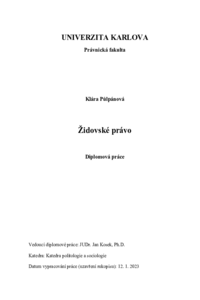Židovské právo
Jewish Law
diplomová práce (OBHÁJENO)

Zobrazit/
Trvalý odkaz
http://hdl.handle.net/20.500.11956/179951Identifikátory
SIS: 246896
Kolekce
- Kvalifikační práce [14741]
Autor
Vedoucí práce
Oponent práce
Agha, Petr
Fakulta / součást
Právnická fakulta
Obor
Právo
Katedra / ústav / klinika
Katedra politologie a sociologie
Datum obhajoby
8. 3. 2023
Nakladatel
Univerzita Karlova, Právnická fakultaJazyk
Čeština
Známka
Výborně
Klíčová slova (česky)
halacha, židovské právo, rabínské právo, biblické právo, Tóra, Mišna, Talmud, midot, aguna, mamzer, mesiraKlíčová slova (anglicky)
halakhah, jewish law, rabbinic law, biblical law, Torah, Mishnah, Talmud, midot, agunah, mamzer, mesirahŽidovské právo Abstrakt Diplomová práce představuje židovské právo jako právní systém. V první části seznamuje čtenáře s pojmem halachy a s jeho obsahem. Dále zasazuje vývoj židovského práva do historického kontextu, kdy seznamuje s jeho vývojem jak z historicko-kritického pohledu, tak z tradičního halachického pohledu. Práce dělí židovské právo na biblické a na rabínské právo, rovněž zachycuje a dále rozvádí jednotlivé charakteristiky židovského práva, kterými jsou multivalence, absence centralizace, různorodost názorů halachických učenců a rituální právo jako všudypřítomná součást právních norem. Popisuje také zdroje halachy a uvádí výběr nejvýznamnějších literárních pramenů židovského práva, spolu se stručným uvedením jejich historického vývoje. Jedna kapitola práce je věnována také rabínské hermeneutice. Práce seznamuje se třemi pojetími hermeneutických pravidel neboli midot. Prvním z nich je sedm pravidel Hilelových, druhým je třináct pravidel rabiho Jišmaela a třetím pojetím je třicet dva pravidel rabiho Eliezera. Práce na příkladech ukazuje aplikaci těchto pravidel při exegezi biblických právních norem, a tím zároveň dokresluje pojetí židovského práva jako právního systému a halachické doktríny jako právní vědy. Ve druhé části práce je rozebírán vztah židovského práva k právu státu Izrael. Přestože...
Jewish Law Abstract The diploma thesis presents the Jewish law as a juridical system. In the first part it introduces the reader to the concept of halakhah and its content. Then it places the development of the Jewish law in historical context, introducing its evolution from a historical and critical perspective as well as from a traditional halakhic perspective. The thesis divides the Jewish law into biblical and rabbinic law and also captures and further discusses the various characteristics of the Jewish law, which are multivalence, the absence of centralization, the diversity of opinions of halakhic savants and ritual law as a ubiquitous part of legal norms. It also describes the sources of halakhah and presents a selection of the most important literary sources of the Jewish law, together with a brief account of their historical development. One chapter of the thesis is also devoted to rabbinic hermeneutics. The thesis introduces three concepts of hermeneutical rules called midot. The first one is the seven rules of Hillel, the second one are the thirteen rules of Rabbi Yishmael, and the third concept is the thirty-two rules of Rabbi Eliezer. The thesis demonstrates by examples the application of these rules in the exegesis of biblical legal norms, and thereby also illustrates the concept of the Jewish...
